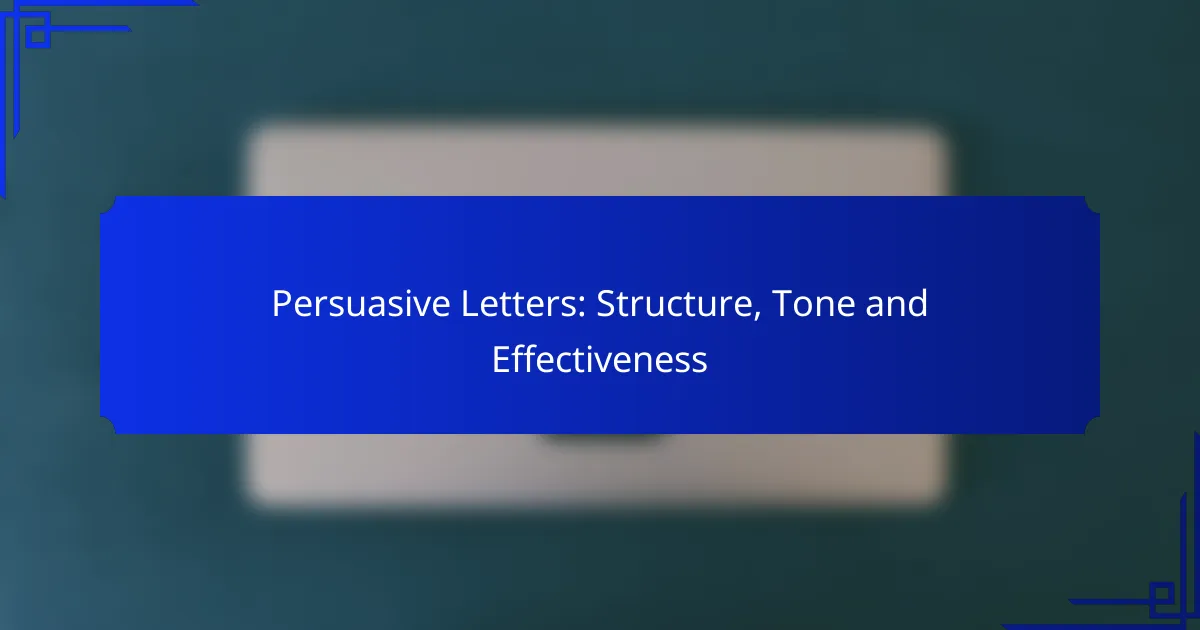Persuasive letters are powerful tools for influencing decisions and actions, requiring a clear and logical structure to effectively convey arguments. An engaging introduction, well-organized body paragraphs, and a compelling conclusion are essential for capturing the reader’s attention and prompting action. Additionally, the tone of the letter plays a critical role in how the message is received, making it vital to choose a suitable approach that resonates with the audience.
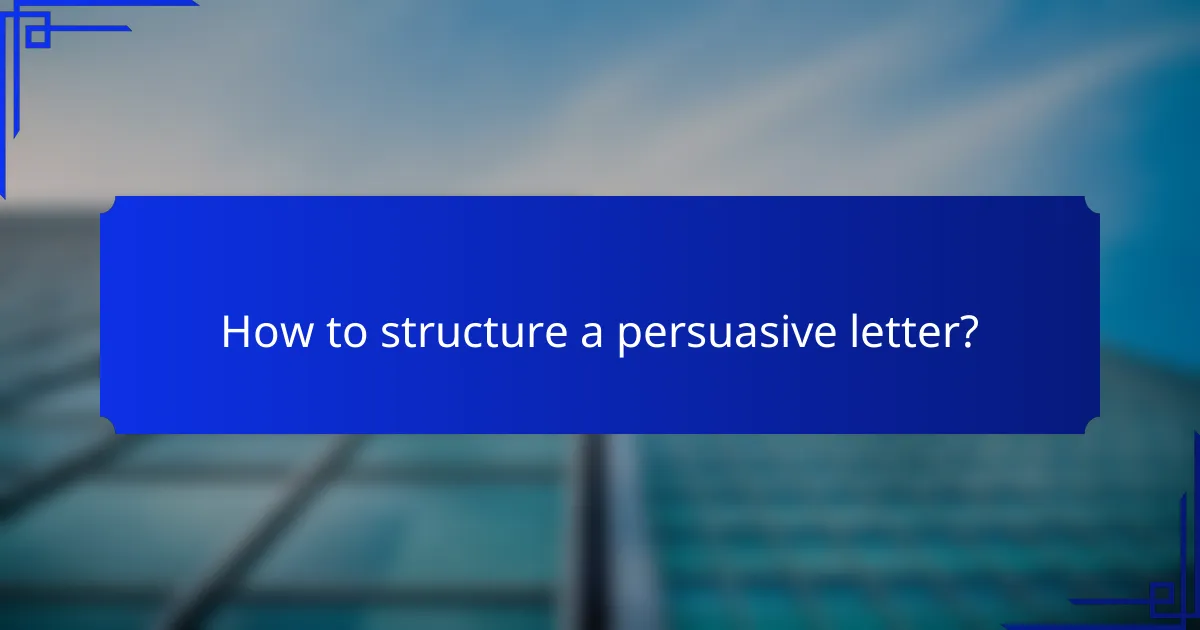
How to structure a persuasive letter?
Structuring a persuasive letter effectively involves organizing your thoughts clearly and logically to convince the reader. A well-structured letter typically includes an engaging introduction, clear body paragraphs that present your arguments, and a compelling conclusion that prompts action.
Introduction with a strong hook
The introduction is crucial for capturing the reader’s attention. Start with a strong hook, such as a thought-provoking question, a surprising fact, or a relatable anecdote that ties into your main argument.
For example, if you’re advocating for environmental changes, you might begin with a statistic about climate change that highlights its urgency. This sets the tone and encourages the reader to continue engaging with your letter.
Clear and concise body paragraphs
Each body paragraph should focus on a single point that supports your overall argument. Begin with a clear topic sentence, followed by evidence or examples that reinforce your claim.
Keep paragraphs concise, ideally 3-5 sentences, to maintain clarity and focus. Use bullet points for lists or comparisons, as they can enhance readability and emphasize key points effectively.
Compelling conclusion with a call to action
Your conclusion should summarize the main points and reinforce the importance of your message. End with a strong call to action, encouraging the reader to take specific steps, whether it’s signing a petition, making a donation, or simply reflecting on the issue.
For instance, you might say, “Join us in advocating for cleaner air by contacting your local representatives today.” This not only wraps up your letter but also motivates the reader to act immediately.
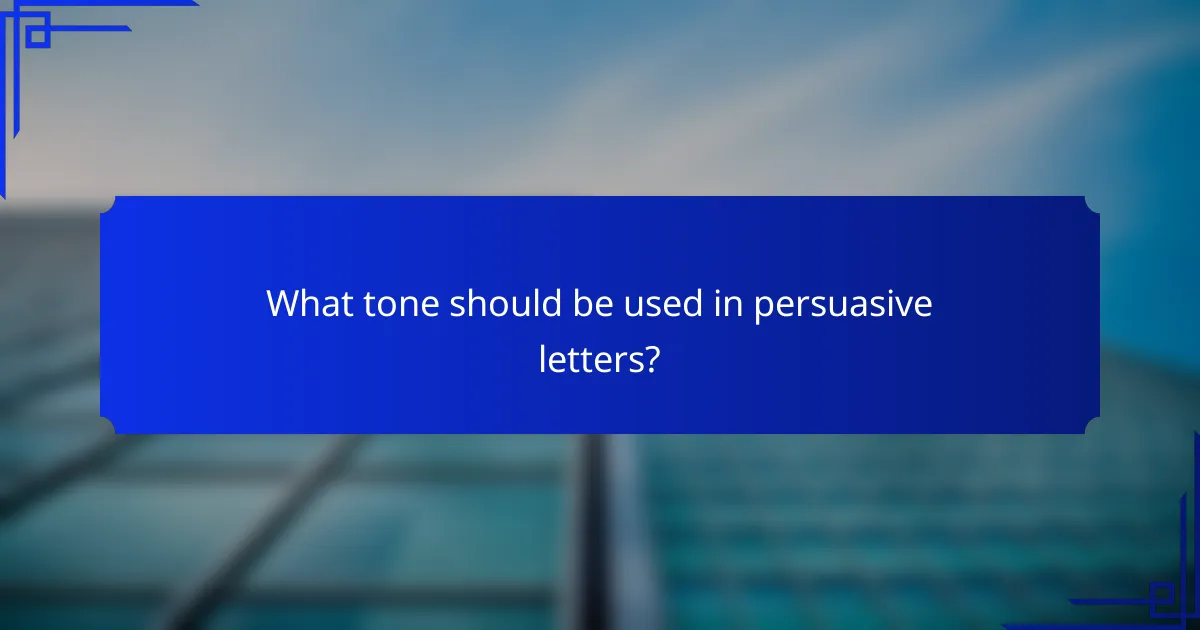
What tone should be used in persuasive letters?
The tone of a persuasive letter is crucial for its effectiveness, as it influences how the message is received. A suitable tone can engage the reader and strengthen the argument, making it more likely for them to respond positively.
Formal tone for professional contexts
In professional settings, a formal tone is essential. This includes using polite language, complete sentences, and a structured format. Address the recipient appropriately, using titles and last names unless invited to use first names.
For example, instead of saying “I think you should approve my proposal,” you might say, “I respectfully request your consideration of my proposal for funding.” This approach conveys respect and professionalism, which can enhance your credibility.
Conversational tone for personal letters
A conversational tone is more suitable for personal letters, allowing for a friendly and approachable style. This tone often includes informal language, personal anecdotes, and a relaxed structure, making the message feel more genuine and relatable.
For instance, instead of stating, “I believe you should consider my suggestion,” you could say, “I really think you’d love this idea!” This friendly approach can foster a connection with the reader, increasing the likelihood of a positive response.
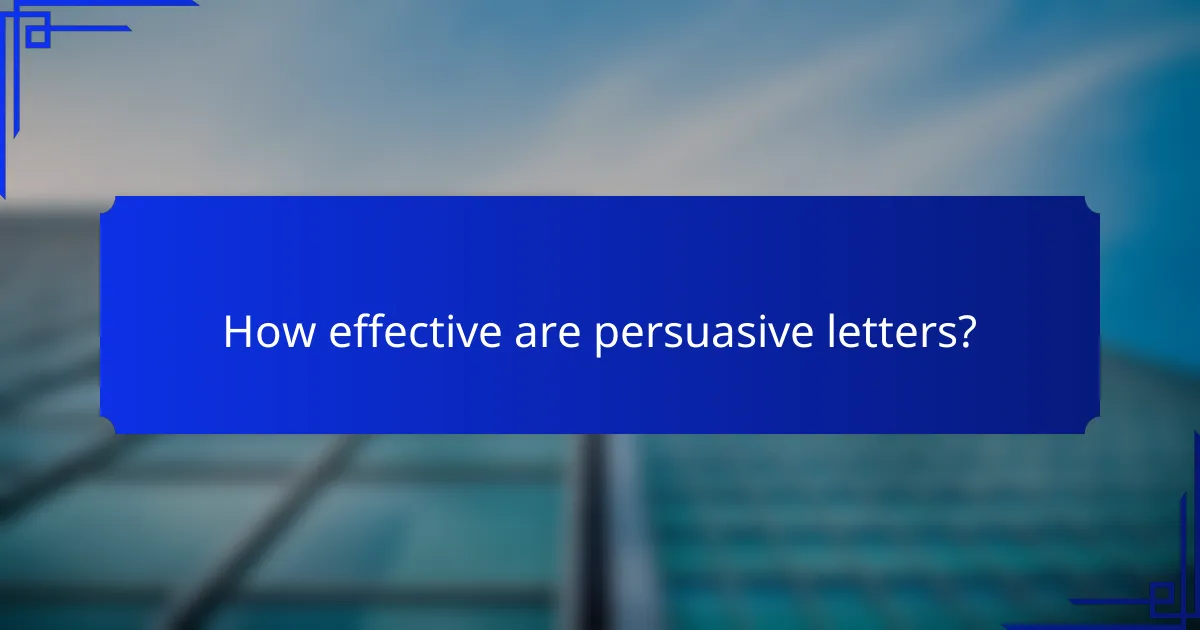
How effective are persuasive letters?
Persuasive letters can be highly effective in influencing decisions and actions. Their success largely depends on the clarity of the argument, emotional appeal, and the relationship between the writer and the recipient.
High impact on decision-making
Persuasive letters often play a crucial role in decision-making processes by presenting compelling arguments and clear calls to action. When structured effectively, they can lead to significant changes in opinion or behavior, especially in business or political contexts.
To maximize impact, focus on presenting logical reasoning supported by evidence. Use bullet points to highlight key benefits or consequences, making it easier for the reader to digest the information quickly.
Influence on reader’s emotions
Emotional appeal is a powerful tool in persuasive letters, as it can resonate deeply with the reader. By tapping into feelings such as empathy, urgency, or hope, writers can create a connection that motivates the recipient to respond positively.
Consider using personal anecdotes or vivid imagery to evoke emotions. However, balance emotional appeal with factual content to maintain credibility and avoid manipulation.

What are common mistakes in persuasive letters?
Common mistakes in persuasive letters often undermine their effectiveness. These include a lack of clarity and focus, as well as the use of overly aggressive language, both of which can alienate the reader and weaken the argument.
Lack of clarity and focus
A persuasive letter must have a clear message and purpose. If the main point is buried under excessive details or tangents, the reader may lose interest or misunderstand the intent. Aim for a concise structure that highlights the key argument early on.
To maintain clarity, use straightforward language and avoid jargon unless necessary. Break complex ideas into simple, digestible parts. For example, instead of saying “utilize,” simply say “use.” This helps keep the reader engaged and focused on your main message.
Overly aggressive language
Using overly aggressive language can backfire in persuasive letters. While it’s important to convey urgency or importance, aggressive tones can alienate the reader and provoke defensiveness. Instead, opt for assertive yet respectful language that invites dialogue.
Consider phrases that emphasize collaboration rather than confrontation. For instance, instead of saying “You must agree with me,” try “I believe we can find common ground.” This approach fosters a more constructive conversation and increases the likelihood of a positive response.

What are the prerequisites for writing a persuasive letter?
Writing a persuasive letter requires a clear understanding of your audience, thorough research on the topic, and a well-structured argument. These elements ensure that your message resonates and effectively influences the reader’s perspective.
Understanding the audience
Knowing your audience is crucial for crafting a persuasive letter. Tailor your language, tone, and content to align with the values and interests of the reader. For instance, if addressing a business executive, use formal language and focus on financial benefits.
Consider demographic factors such as age, profession, and cultural background. Understanding these aspects helps you anticipate objections and frame your arguments in a way that appeals to the reader’s motivations.
Researching the topic thoroughly
Comprehensive research is essential for a persuasive letter. Gather relevant data, statistics, and examples that support your argument. This not only strengthens your position but also builds credibility with the reader.
Utilize reputable sources and ensure that your information is up-to-date. A well-researched letter can include facts about market trends, consumer behavior, or legal regulations that pertain to your argument, making it more compelling.

How to choose the right format for a persuasive letter?
Choosing the right format for a persuasive letter is essential for effectively conveying your message. The format sets the tone and can influence how your argument is received, whether you opt for a formal business letter or a more casual personal letter.
Business letter format for formal letters
A business letter format is ideal for formal communications, such as requests or proposals to organizations or individuals in professional settings. This format typically includes your address, the date, the recipient’s address, a formal greeting, the body of the letter, a closing, and your signature.
When writing a formal letter, ensure clarity and professionalism. Use a standard font like Times New Roman or Arial, and keep the letter aligned to the left. Avoid overly complex language; instead, focus on concise and persuasive arguments that directly address the recipient’s interests or needs.
Personal letter format for informal letters
The personal letter format is suitable for informal communications, such as requests to friends or family. This format is more flexible and can include a casual greeting, a conversational tone, and a less rigid structure.
In a personal letter, you can express your emotions and opinions more freely. While it’s still important to be persuasive, you can use anecdotes or personal stories to strengthen your argument. Remember to keep the letter friendly and approachable, which can help engage the reader more effectively.
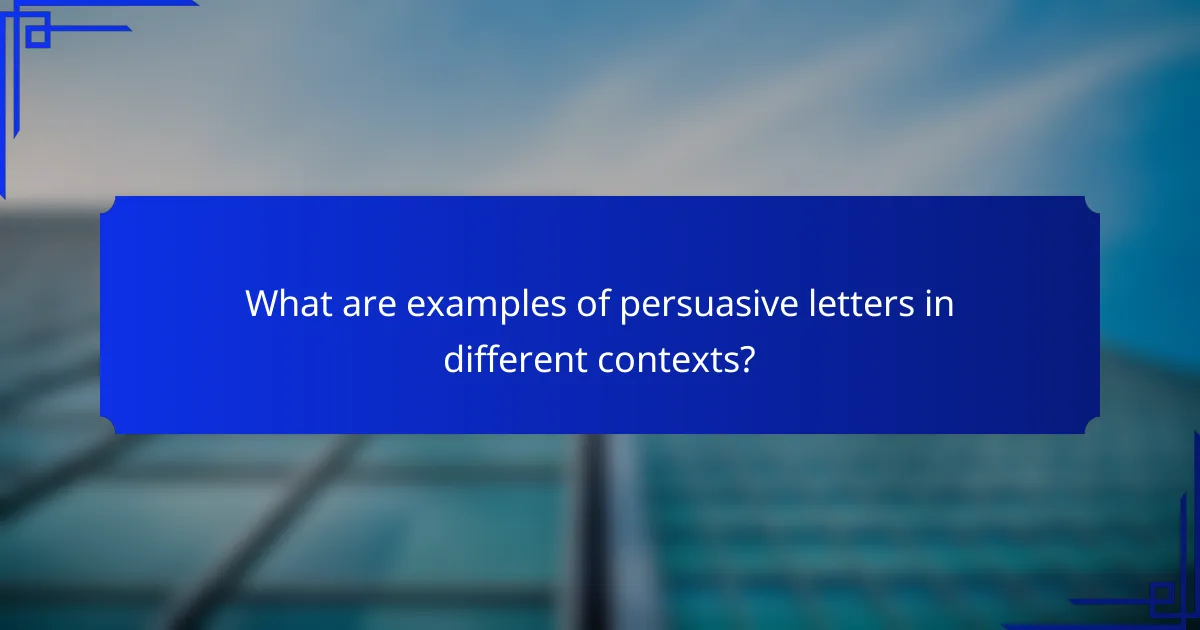
What are examples of persuasive letters in different contexts?
Persuasive letters are written to convince the reader to take a specific action or adopt a particular viewpoint. Common examples include sales letters aimed at potential customers and cover letters that accompany job applications.
Sales letters for marketing
Sales letters are crafted to persuade potential customers to purchase a product or service. They typically highlight the benefits of the offering, address customer pain points, and include a strong call to action. A well-structured sales letter often starts with an engaging opening, followed by persuasive arguments and testimonials.
When writing a sales letter, focus on the target audience’s needs and desires. Use clear language and avoid jargon to ensure the message is accessible. Including limited-time offers or discounts can create urgency, encouraging quicker responses from potential buyers.
Cover letters for job applications
Cover letters serve to introduce applicants to potential employers, emphasizing their qualifications and interest in a specific position. A successful cover letter connects the applicant’s skills to the job requirements, showcasing how they can add value to the company. Personalization is key; addressing the hiring manager by name can make a positive impression.
In crafting a cover letter, keep it concise—ideally one page—and ensure it complements the resume rather than repeating it. Highlight relevant experiences and achievements that align with the job description. Avoid generic phrases; instead, tailor your message to reflect the company’s values and culture.

What emerging trends are shaping persuasive letter writing?
Emerging trends in persuasive letter writing are heavily influenced by digital communication and evolving audience expectations. These trends emphasize clarity, brevity, and the use of technology to enhance engagement and effectiveness.
Incorporation of digital communication
Digital communication has transformed persuasive letter writing by allowing for quicker and more interactive exchanges. Emails, social media messages, and online platforms enable writers to reach their audience instantly, making it essential to adapt traditional letter formats to fit these mediums.
When writing persuasive letters in a digital context, consider using concise language and direct calls to action. For example, instead of lengthy paragraphs, use bullet points to highlight key arguments or benefits, making it easier for readers to grasp the main points quickly.
Additionally, incorporating multimedia elements such as links, images, or videos can enhance the persuasive impact of your message. However, ensure that these elements are relevant and do not distract from the core message, as clarity should remain a priority in digital correspondence.
